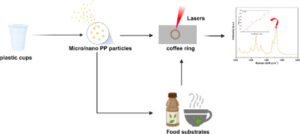Abstract:  Polypropylene (PP) is suitable for a broad range of applications and represents the most extensively utilized plastic in food packaging. Micro- and nano-PP plastics are prevalent categories of microplastics (MPs). However, the majority of MPs particles currently utilized in laboratory studies are man-made polystyrene (PS) spheres, and there has been limited research on micrometer- and nanoscale PP plastic particles. This study aims to employ a top-down approach in crafting micro/nanoparticle (M/NPs) models of PP particles, ensuring their enhanced relevance to real-world environments. Micro/nano PP particles, featuring a negatively charged particle size ranging from 203 to 2101 nm, were synthesized through variations in solution concentration and volume. Simultaneously, the devised MPs model was employed to develop a Raman-based qualitative and quantitative detection method for micro/nano PP particles, considering diverse sizes and concentrations. This method integrates Raman spectroscopy and microscopy to measure PP particles with varying sizes, utilizing the coffee ring effect. The Limit of detection (LOD) for 203 nm PP reached 31.25 μg/mL, while those for 382 to 2101 nm PP were approximately 3.9 μg/mL. The method underwent quantitative analysis by introducing 203 nm PP nanospheres into real food media (i.e., tea beverages, tea leaves), revealing a minimum LOD of approximately 31.25 μg/mL.
Polypropylene (PP) is suitable for a broad range of applications and represents the most extensively utilized plastic in food packaging. Micro- and nano-PP plastics are prevalent categories of microplastics (MPs). However, the majority of MPs particles currently utilized in laboratory studies are man-made polystyrene (PS) spheres, and there has been limited research on micrometer- and nanoscale PP plastic particles. This study aims to employ a top-down approach in crafting micro/nanoparticle (M/NPs) models of PP particles, ensuring their enhanced relevance to real-world environments. Micro/nano PP particles, featuring a negatively charged particle size ranging from 203 to 2101 nm, were synthesized through variations in solution concentration and volume. Simultaneously, the devised MPs model was employed to develop a Raman-based qualitative and quantitative detection method for micro/nano PP particles, considering diverse sizes and concentrations. This method integrates Raman spectroscopy and microscopy to measure PP particles with varying sizes, utilizing the coffee ring effect. The Limit of detection (LOD) for 203 nm PP reached 31.25 μg/mL, while those for 382 to 2101 nm PP were approximately 3.9 μg/mL. The method underwent quantitative analysis by introducing 203 nm PP nanospheres into real food media (i.e., tea beverages, tea leaves), revealing a minimum LOD of approximately 31.25 μg/mL.
Xiang T, Sun Y, Ding D, Yao W, Yu Z, Xie Y. Microscopic Raman-based rapid detection of submicron/nano polypropylene plastics in tea and tea beverages. Food Chem. 2024 May 16;454:139657. doi: 10.1016/j.foodchem.2024.139657. Epub ahead of print. PMID: 38810455.
